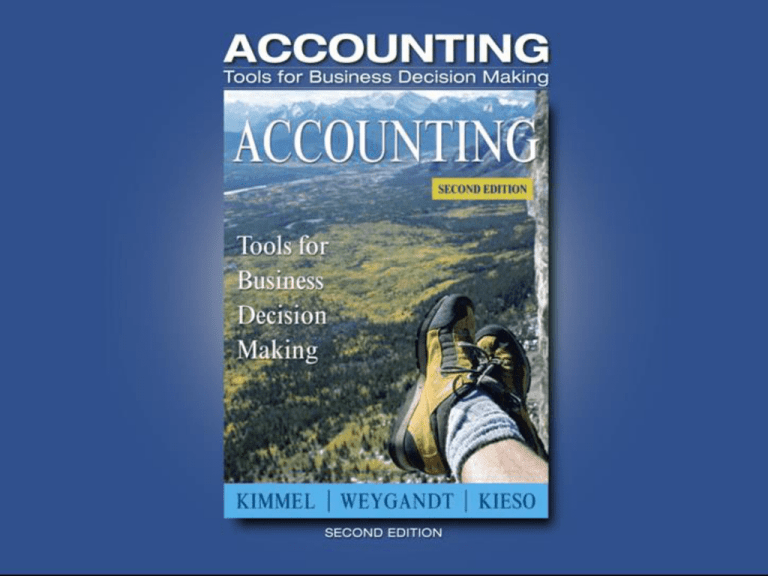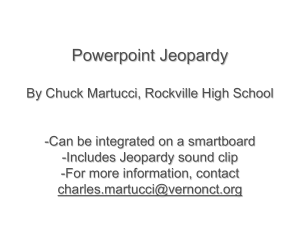
1
Chapter 9
REPORTING AND
ANALYZING LONGLIVED ASSETS
2
Chapter 9
Reporting and Analyzing
Long-Lived Assets
After studying this chapter, you should be able to:
1. Describe how the cost principle applies
to plant assets.
2. Explain the concept of depreciation.
3. Compute periodic depreciation using the
straight-line method, and contrast its
expense pattern with those of other
methods.
4. Describe the procedure for revising
periodic depreciation.
3
Chapter 9
Reporting and Analyzing
Long-Lived Assets
5. Explain how to account for the disposal
of plant assets.
6. Describe methods for evaluating the use
of plant assets.
7. Identify the basic issues related to
reporting intangible assets.
8. Indicate how long-lived assets are
reported on the balance sheet.
4
1
11
Cost of Plant Assets
Plant assets are resources that
• have physical substance
• are used in the operations of a business
• are not intended for sale to customers
Plant assets are recorded at cost
• cost consists of all expenditures
necessary to acquire the asset and
make it ready for its intended use
5
Plant Assets
Cost is measured by
• the cash paid in a cash transaction, or
• the cash equivalent price paid when noncash
assets are used in payment.
The cash equivalent price is equal to
• the fair market value of the asset given up, or
• the fair market value of the asset received,
whichever is more clearly determinable.
6
Plant Assets
Land
Cost of land includes
• Cash price, closing costs, brokers’
commissions, accrued property taxes,
etc.
• Can also include costs to raze a building,
drain and fill the land
• Proceeds from sale of salvaged
materials are deducted from the cost
7
Cost of Land Improvements
All expenditures necessary to make
the improvements ready for their
intended use
•
•
•
•
Drive ways
Parking lots
Fences
Underground sprinklers
8
Buildings
All necessary expenditures relating
to the purchase or construction of
a building.
When a building is purchased such
costs include the
• purchase price
• closing costs (attorney's fees title
insurance)
• real estate broker's commissions
9
Buildings
If a building is purchased, but
needs to be readied for its
intended use, cost includes
• expenditures for remodeling
rooms or offices
• replacing or repairing
o roof
o floors
o electrical wiring
o plumbing
10
Buildings
When a building is constructed, its
cost consists of
•
•
•
•
•
the contract price
architect's fees
building permits
excavation cost
interest costs during
construction
11
Equipment
Cost of equipment
includes
• purchase price
• sales tax
• freight charges and insurance
during transit paid by the
purchaser
• expenditures required in
assembling
• installing and testing the unit
12
Review Question
Which of the following is/are properly
classified as plant assets (property,
plant, and equipment)?
I.
II.
III.
a.
b.
c.
d.
Inventory
Machinery
Office supplies
I and II only.
II and III only.
II only.
III only.
13
Review Question
Which of the following is/are properly
classified as plant assets (property,
plant, and equipment)?
I. Inventory
II. Machinery
III. Office supplies
a.
b.
c.
d.
I and II only.
II and III only.
II only.
III only.
14
2
11
Depreciation
The process of allocating to expense the cost of
a plant asset over its useful life in a rational and
systematic manner.
15
Depreciation
Three classes of plant assets are
depreciated
• Land improvements
• Buildings
• Equipment
Land is NOT depreciated
16
Factors in Computing
Depreciation
17
3
11
Depreciation Methods
Straight-line
Declining-balance
Units-of-activity
18
Straight-line Method
Depreciable Cost*
______________________________________________________________________________________
The asset's useful life measured in years
*(cost of the asset less its salvage value)
19
Straight-Line Depreciation
Formula
20
Declining-Balance Method
Is an accelerated
method.
Accelerated
methods of
depreciation result
in more
depreciation in the
early years of an
asset's life and less
depreciation in the
later years.
21
Units-of-Activity Method
The life of an asset is
expressed in terms
of the total units of
production or the
use expected from
the asset.
The amount of
depreciation is
proportional to the
activity that took
place during the
period.
22
Patterns of Depreciation
23
Depreciation and Income
Taxes
• The IRS allows corporate taxpayers to
deduct depreciation when computing
taxable income.
• The IRS does not require the taxpayer to
use the same depreciation method on the
tax return that is used in preparing
financial statements.
24
Depreciation and Income
Taxes
Many large corporations use straight-line depreciation
in their financial statements to maximize net income.
At the same time they use a special accelerateddepreciation method on their tax returns to minimize
their income taxes.
The choice of depreciation method
must be disclosed in the
notes to financial statements.
25
5
11
Plant Asset Disposals
26
Sale of Plant Assets
In the sale of an asset, the book
value of the asset is compared with
the proceeds from the sale.
• If the proceeds exceed the book
value a gain on disposal occurs.
• If proceeds from the sale are less
than the book value a loss on
disposal occurs.
27
Retirement of Plant Assets
A retirement is recorded by
• decreasing Accumulated Depreciation for the
full amount of depreciation taken over the life
of the asset, and
• decreasing the asset account for the original
cost of the asset.
The loss is equal to the asset's book
value at the time of retirement (a gain is
not possible).
28
Types of Intangible Assets
Patents
Copyrights
Trademark or Trade Names
Franchises and Licenses
Goodwill
PATENT
29
Intangible Assets
Intangible assets are recorded at cost
If the intangible has a limited useful life,
its cost is allocated (amortized) over the
useful life.
If the intangible has an indefinite life, it is
not amortized.
30
Patents
Patents are an exclusive right that enables
the recipient to manufacture, sell, or
control a patent for 20 years from the date
of grant.
The initial cost of a patent is cash or cash
equivalent price paid to acquire the patent.
Legal costs of protecting a patent are
added to the Patent account and amortized
over the remaining life of the patent.
31
Copyrights
Copyrights are granted by the federal
government giving the owner the
exclusive right to reproduce and sell
artistic or published work.
Copyrights extend for the life of the
creator plus 70 years.
32
Presentation Of Long-lived
Assets
Contra accounts
• Plant assets make use of a contra account “Accumulated
Depreciation”
• Amortization of intangible assets is generally recorded
directly to the asset account
33
Copyright © 2008 John Wiley & Sons, Inc. All rights
reserved. Reproduction or translation of this work
beyond that named in Section 117 of the United States
Copyright Act without the express written consent of the
copyright owner is unlawful. Request for further
information should be addressed to the Permissions
Department, John Wiley & Sons, Inc. The purchaser
may make back-up copies for his/her own use only and
not for distribution or resale. The Publisher assumes no
responsibility for errors, omissions, or damages, caused
by the use of these programs or from the use of the
information contained herein.
34




